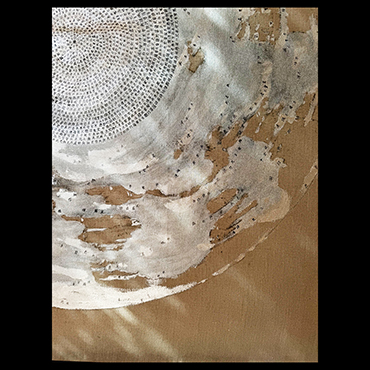Born 1980 in Taipei, Taiwan,
lives and works between her place
of birth and Paris, France
Charwei Tsai uses various media in her visual and performative art practice, informed by geographical, social, and spiritual concerns. Preoccupied with the human relationship to nature, Tsai meditates on the complexities of transience and cultural beliefs. She has a BFA in Industrial Design and Art & Architectural History from the Rhode Island School of Design (2002), and completed the postgraduate research program La Seine at L’École Nationale Supérieure des Beaux-Arts, Paris (2010). Tsai has published the curatorial journal Lovely Daze twice a year since 2005. She exhibited at Rubin Museum, New York (2024); 15th Gwangju Biennale (2023); Mori Art Museum, Tokyo (2023); Centre Pompidou, Paris (2022); Jogja Biennale (2019); Biennale of Sydney (2016); and Sharjah Biennial (2013).
That Which at First Tastes Bitter
Charwei Tsai’s installation responds to the AH 360–90/975–1000 CE ceramic dish from Samarkand, Uzbekistan, belonging to the Musée du Louvre Collection. The work expands upon the historic object’s striking qualities such as the central black motif and its Kufic calligraphy. The motif is composed of two parts in union as a circle, with a void in the center, creating a sense of rhythmic flow and alluding to an expanded cosmos. The Kufic calligraphy, meanwhile, radiates from the wide rim of the plate with a balance between form and void. The inscribed maxim, specifically its first character, could be interpreted as Al-hilm: patience, tolerance; or ‘Ilm: knowledge.
Tsai devises a circular space based on the colors of the plate–creamy ivory, with a dark brown inscription. Its white elongated openings create a path around the historic object, which is placed at the center on a dark pedestal inspired by the plate’s black motif. The surrounding walls are covered with a painting made from mother of pearl pigment and the artist’s repeated inscription of the first Kufic character of the plate, following the circular motions of the painting. Through the repetitive gesture of inscribing this character, the work becomes a meditation on the same virtues inscribed on the ceramic.
2025
Mica pigment and ink on linen
h. 3.95 × w. 78.5889 m (each panel)

